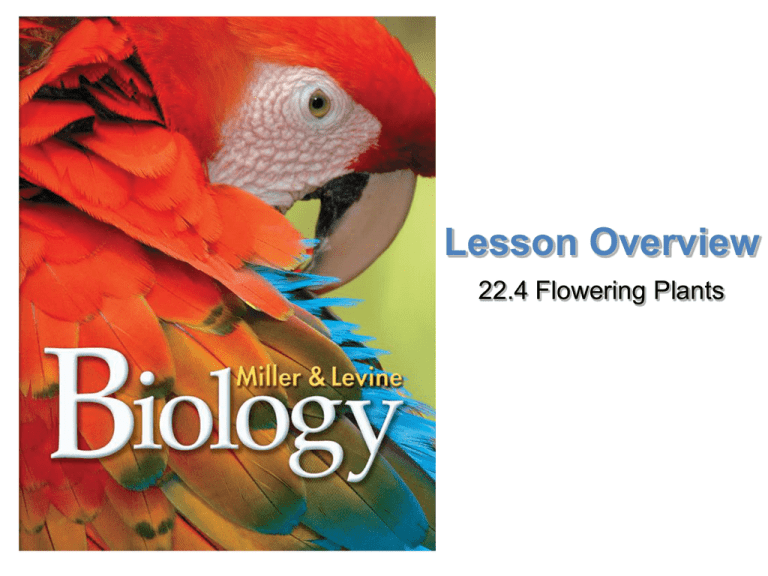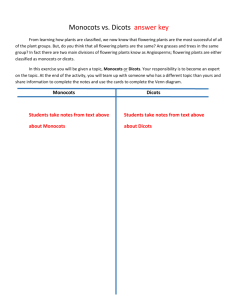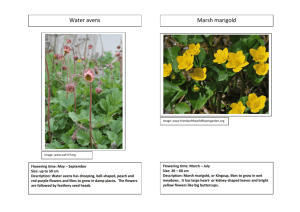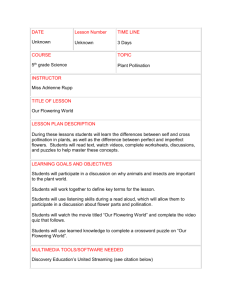Lesson Overview
advertisement

Lesson Overview 22.4 Flowering Plants Lesson Overview Flowering Plants THINK ABOUT IT Flowering plants are by far the most abundant organisms in the plant kingdom, and yet they evolved much more recently than did other seed plants. What features of these plants enabled them to take Earth by storm? What are the secrets of their success? Lesson Overview Flowering Plants Flowers and Fruits What are the key features of angiosperm reproduction? Lesson Overview Flowering Plants Flowers and Fruits What are the key features of angiosperm reproduction? Angiosperms reproduce sexually by means of flowers. After fertilization, ovaries within flowers develop into fruits that surround, protect, and help disperse the seeds. Lesson Overview Flowering Plants Flowers and Fruits The origin of flowering plants is the most recent among the origins of all plant phyla. Flowering plants originated on land and soon came to dominate Earth’s plant life. Lesson Overview Flowering Plants Flowers and Fruits Angiosperms develop unique reproductive organs known as flowers, shown in the figure. Flowers contain ovaries, which surround and protect seeds. Lesson Overview Flowering Plants Advantages of Flowers Flowers are an evolutionary advantage to plants because they attract animals that carry pollen with them to the next flower they visit. This means of pollination is much more efficient than the wind pollination of most gymnosperms. Lesson Overview Flowering Plants Advantages of Fruits After pollination, the ovary develops into a fruit, a structure containing one or more matured ovaries. The wall of the fruit helps disperse the seeds contained inside it. The development of the multiple ovaries of a blackberry flower into the cluster of fruits that make up one berry is shown. Lesson Overview Flowering Plants Advantages of Fruits When an animal eats a fleshy fruit, seeds from the fruit enter the animal’s digestive system. By the time the seeds leave the digestive system, the animal may have traveled many kilometers. By using fruit, flowering plants increase the ranges they inhabit. Lesson Overview Flowering Plants Angiosperm Classification When an animal For many years, flowering plants were classified according to the number of seed leaves, or cotyledons, in their embryos. Those with one seed leaf were called monocots. Those with two seed leaves were called dicots. Lesson Overview Flowering Plants Angiosperm Classification Scientific classification places the monocots into a single group but places the dicots in different categories. Lesson Overview Flowering Plants Angiosperm Diversity How are different angiosperms conveniently categorized? Lesson Overview Flowering Plants Angiosperm Diversity How are different angiosperms conveniently categorized? Angiosperms are often grouped according to the number of their seed leaves, the strength and composition of their stems, and the number of growing seasons they live. Lesson Overview Flowering Plants Monocots and Dicots The differences between monocots and dicots include the distribution of vascular tissue in stems, roots, and leaves, and the number of petals per flower. Lesson Overview Flowering Plants Monocots and Dicots The characteristics of monocots and dicots are compared in the table below. Lesson Overview Flowering Plants Woody and Herbaceous Plants Flowering plants can be subdivided into groups according to the characteristics of their stems. Woody plants are made primarily of cells with thick cell walls that support the plant body. Herbaceous plants have stems that are smooth and nonwoody. Lesson Overview Flowering Plants Annuals, Biennials, and Perennials: Characteristics and Examples








